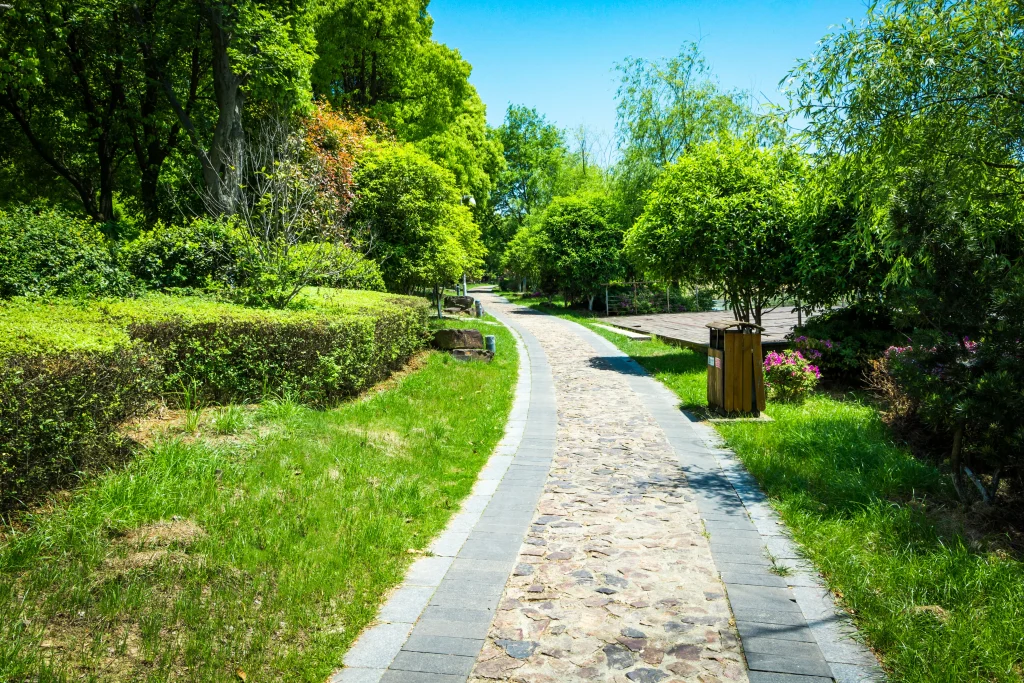Black rock landscaping has become one of the hottest trends for good reason. Sleek, low-maintenance, and drought-friendly, black landscape rocks bring a modern edge to Colorado yards.
In this guide, you’ll discover how to design a modern black rock landscape that fits your home – from rock types and design ideas, plant pairings, and maintenance tips.
Let’s explore why this trend is taking root in Mile High City neighborhoods and how you can make it work for your property.
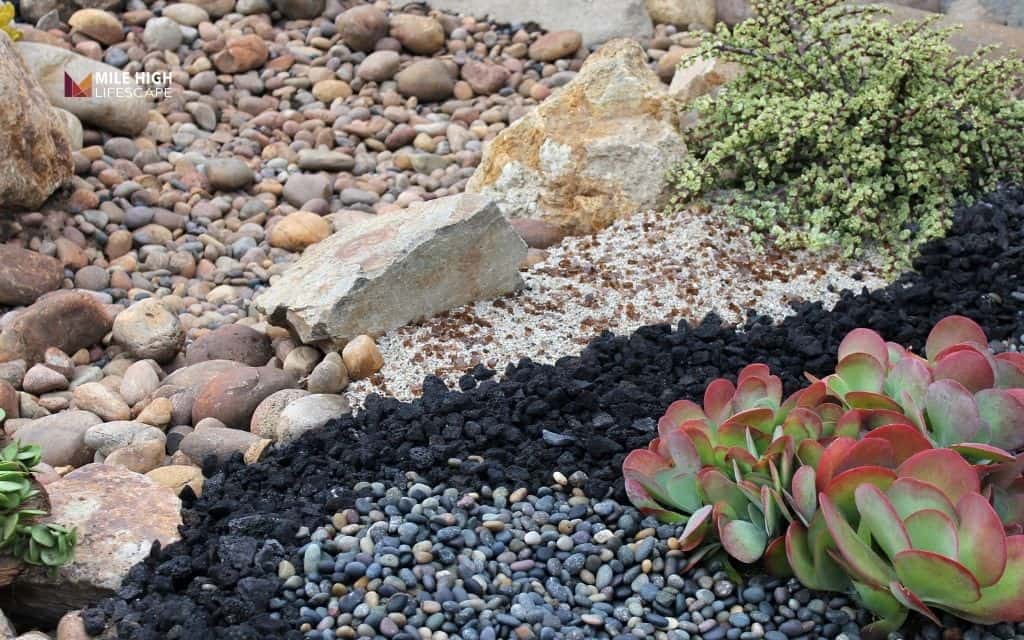
Why black rock landscaping is trending
A perfect match for Colorado’s climate
Unlike lighter-colored rocks that can create intense glare and heat reflection, black rocks absorb heat during the day and release it, which can actually benefit plants during chilly nights.
They help conserve precious water making them ideal for xeriscape and drought-tolerant yards that align with Denver Water’s conservation guidelines.
Black rock also stands up exceptionally well to our dramatic temperature swings. From summer days to winter nights, these durable materials won’t crack, fade, or decompose the way organic mulches do.
They handle our frequent freeze-thaw cycles without shifting excessively, and they won’t blow away during those notorious Colorado windstorms.
Aesthetic appeal for modern homes
Black rocks create stunning visual contrast against Denver’s abundant sunshine and bright blue skies. They add structure and texture to outdoor designs without overwhelming the space.
When paired with the natural wood, steel, and concrete hardscapes common in contemporary homes, black rock creates a cohesive, intentional look that elevates your entire curb appeal.
The boldness of black landscaping rocks also creates excellent definition.
They clearly delineate garden beds, pathways, and functional zones in your yard, giving your outdoor space the same thoughtful design treatment that modern homeowners apply to their interiors.
Long-term savings
Black rock landscaping requires minimal maintenance compared to lawns or organic mulch. There’s no mowing, no fertilizing, and drastically reduced watering needs.
While the initial investment may be higher than seeding a lawn, black rocks last for decades without fading, decomposing, or requiring replacement.
This longevity means your landscaping investment actually appreciates over time as it reduces your ongoing water bills and upkeep costs.
Types of black rocks for landscaping
Choosing the right type of black rock is crucial for achieving your desired look and functionality. Here’s a detailed breakdown of the most popular options available to Denver homeowners:
| Rock Type | Description | Ideal Use | Price (per ton, Denver avg.) |
| Black Lava Rock | Porous volcanic rock with natural texture and lightweight feel | Beds, borders, xeriscapes | $100 – $150 |
| Black Granite | Heavy, elegant, and durable with a refined appearance | Driveways, walkways, modern gardens | $120 – $180 |
| Black Polished Pebbles | Smooth river-like finish that catches light beautifully | Accent areas, planters, pathways | $180 – $250 |
| Basalt Crushed Rock | Angular, matte appearance with natural stone texture | Large-scale modern designs | $90 – $140 |
| Black Slate Chips | Flat, layered texture with natural cleft surfaces | Patio edging, ground cover | $100 – $160 |
When selecting your rock type, consider both aesthetics and function.
- Black lava rock works wonderfully for most residential applications – it’s affordable, lightweight (making it easier to work with), and its porous texture creates visual interest.
- Black granite makes a bold statement and handles foot traffic beautifully, making it ideal for walkways and high-use areas.
- For accent zones where you want maximum visual impact, polished pebbles create an upscale resort-like feel.
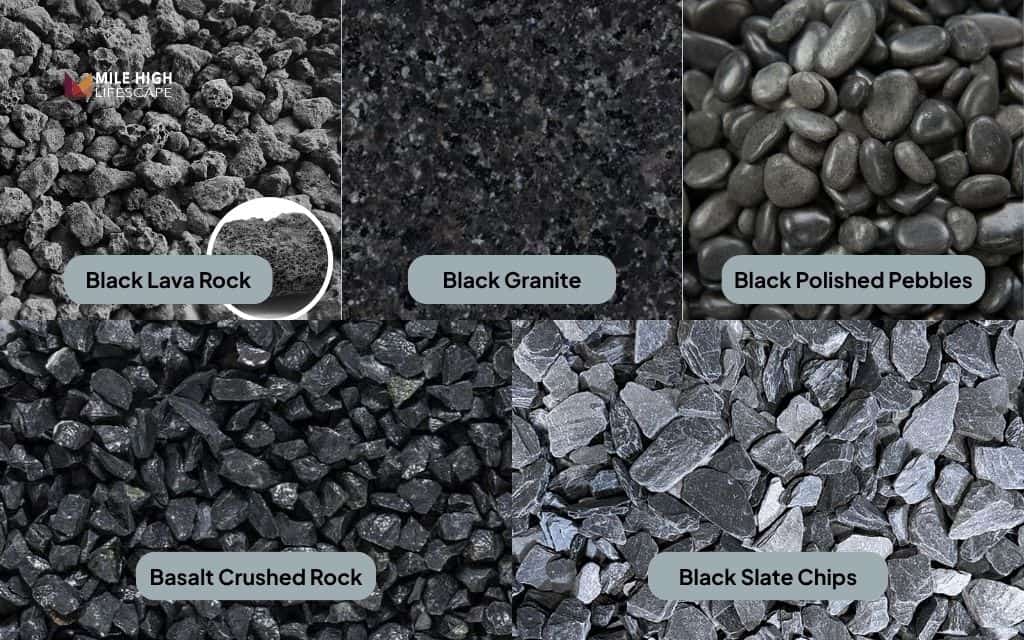
How to design black rock landscaping
Choosing the right size and placement
Rock size dramatically affects the visual weight and scale of your design.
- Select smaller rocks (1 – 2 inches) for front yards or flower beds where you want a refined, uniform appearance.
- Larger stones (3 – 6 inches) create dramatic focal points and work beautifully for edging or anchoring design elements.
When installing your modern black rock landscape, place larger rocks first to anchor the design and create visual hierarchy. This establishes the “bones” of your landscape. Then fill in with medium and smaller rocks, creating a natural gradation that guides the eye through your space.
Layering techniques
Here’s the proven method for creating a modern black rock landscape:
- Start with a base layer of crushed gravel or decomposed granite for drainage. A 2 – 3 inch base layer allows water to percolate while preventing muddy spots.
- Add a commercial-grade weed barrier fabric. This step reduces maintenance by preventing weed seeds in the underlying soil from reaching the surface.
- Choose a permeable fabric that allows water infiltration while blocking light.
- Top with mixed-size black rocks for a natural yet polished texture. Combining different sizes (for example, a base of 2-inch basalt with scattered 4 – 6 inch accent stones) creates visual depth and prevents that flat, artificial appearance.
- Consider combining textures as well – matte basalt under a sparse layer of polished pebbles creates sophisticated contrast that catches light without overwhelming your design.
Creating the perfect balance
The most successful modern black rock landscape designs balance boldness with restraint.
- Pair dark rocks with light-colored elements such as white pavers, blonde wood fencing, or silver-leaved plants like artemisia or dusty miller,… This interplay of light and dark creates visual interest and prevents your landscape from feeling heavy.
- Limit your color palette to 2–3 tones to maintain modern simplicity. This palette creates sophistication and allows each element to shine rather than competing for attention.
- Use repetition strategically throughout your design. In landscape design, odd-numbered groupings (3, 5, or 7) of plants or accent rocks typically create the most pleasing, natural-looking arrangements.
10 Modern black rock landscape ideas
(Images are for illustrative purposes only)
Minimalist front yard with black basalt
Create instant curb appeal with clean lines, metal edging, and drought-tolerant plants. This design strips away unnecessary elements, focusing on quality materials and thoughtful plant selection. Black basalt provides a uniform, sophisticated backdrop that lets architectural features and carefully chosen plants take center stage.
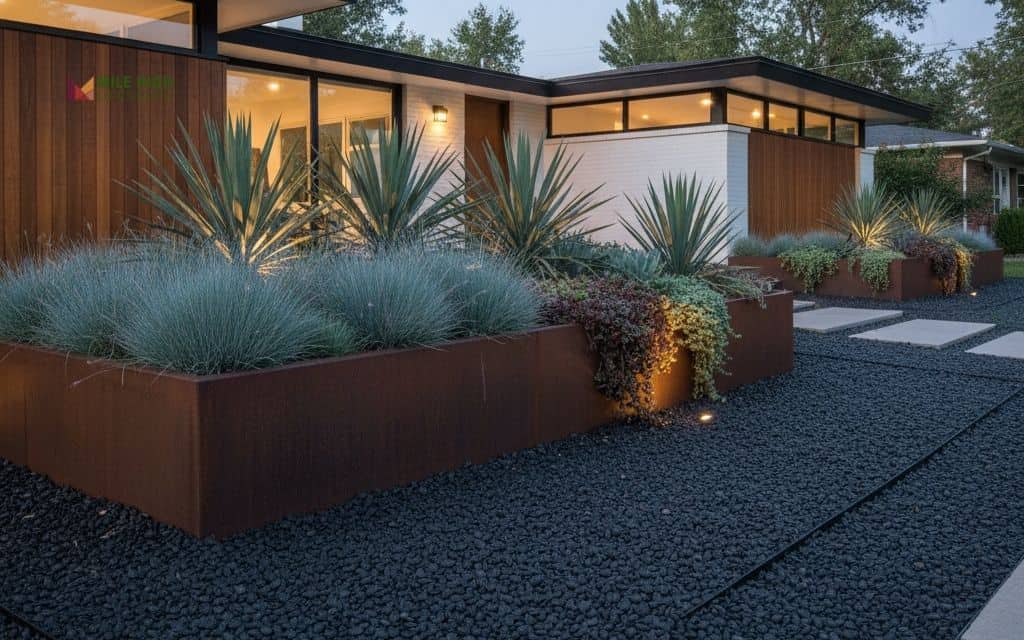
Xeriscape garden with black lava rock
Replace grass with low-water plants surrounded by black lava rock for a sustainable, stylish look that celebrates Colorado’s natural beauty. Lava rock’s porous texture and reddish-black color create visual warmth while providing excellent drainage and weed suppression. Find more lava rock landscaping ideas right here.
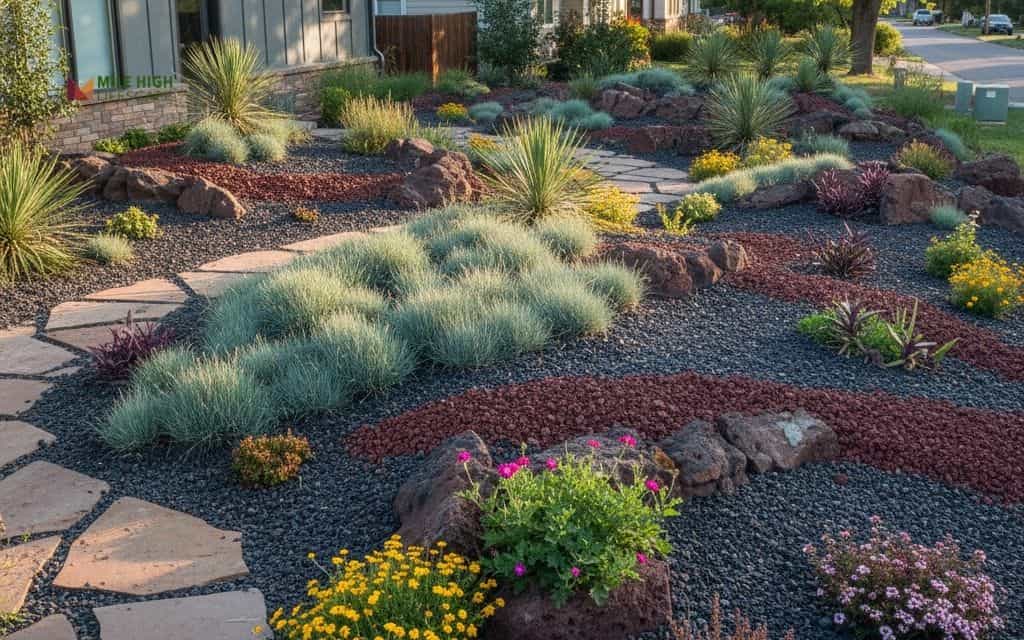
Modern walkway using black granite
Angular granite rocks bordered with LED pathway lights make a strong statement for modern homes. Black granite’s density and refined appearance creates a walkway that’s both functional and sculptural. The clean edges and substantial feel of granite convey quality and permanence.
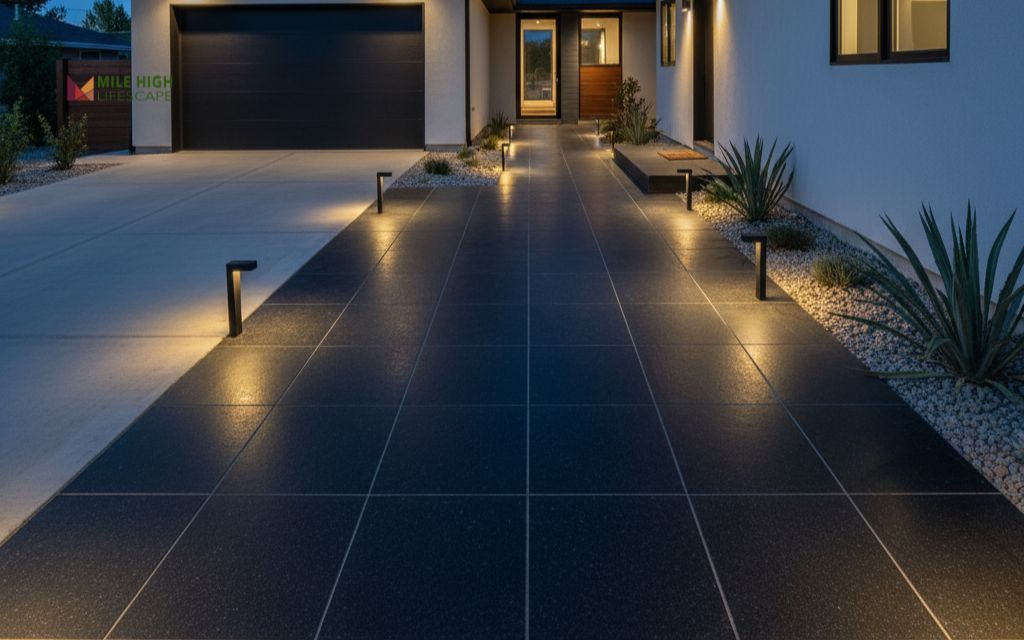
Water feature with black pebbles
Use smooth black stones around fountains or ponds to highlight reflections and movement. Water and black rocks create a mesmerizing combination – the stones’ dark surface makes water appear more luminous and reflective while hiding algae or mineral deposits that might show on lighter-colored rocks.
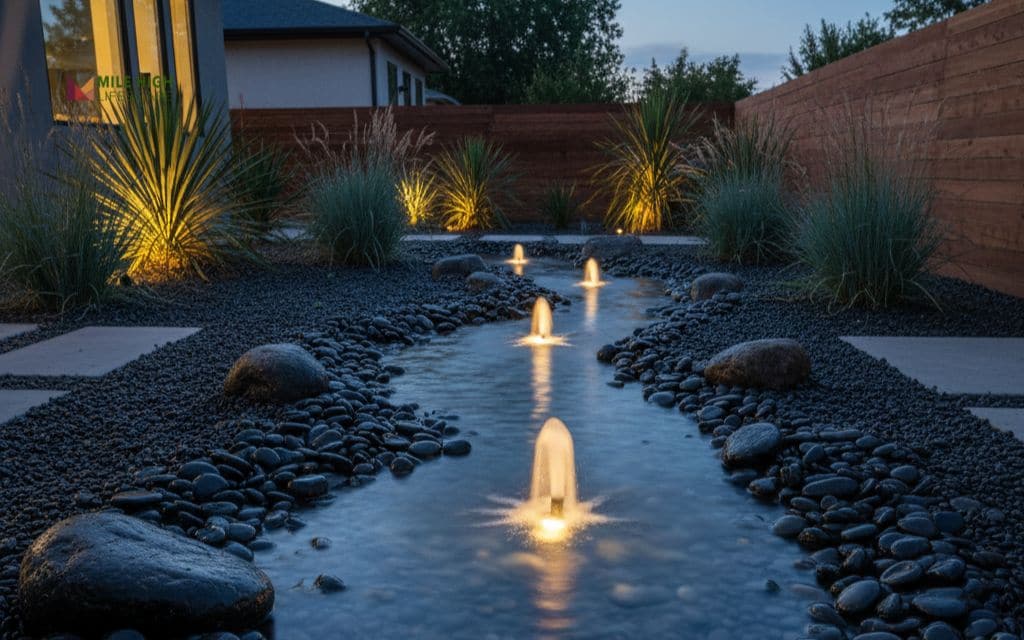
Front yard black landscape rock bed
A simple design using black rocks (black basalt or lava rock), ornamental grasses, and bold succulents enhances curb appeal instantly. This approach works beautifully for Denver’s challenging front yard conditions – high visibility, varied sun exposure, and the need for year-round interest.
Read more: 15+ stunning front yard landscaping ideas with rocks for Colorado area
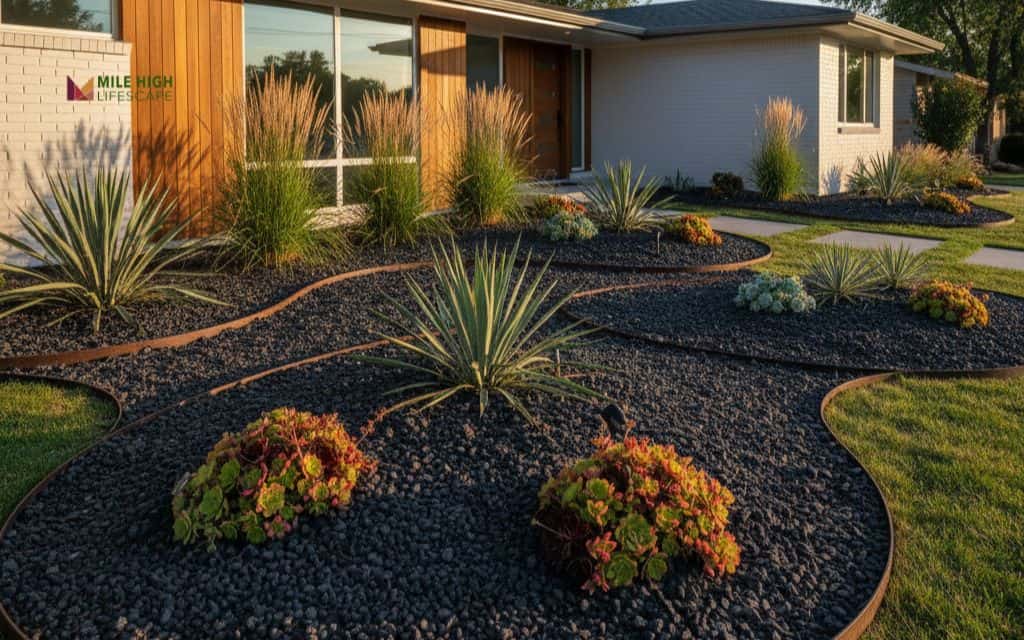
Outdoor fire pit area
Black rock ground cover complements the firelight beautifully while staying cool underfoot. When you’re creating an outdoor living area centered around a fire feature, black rocks provide the perfect foundation. They’re non-combustible, handle high temperatures without damage, and won’t trap embers like grass or wood mulch might.
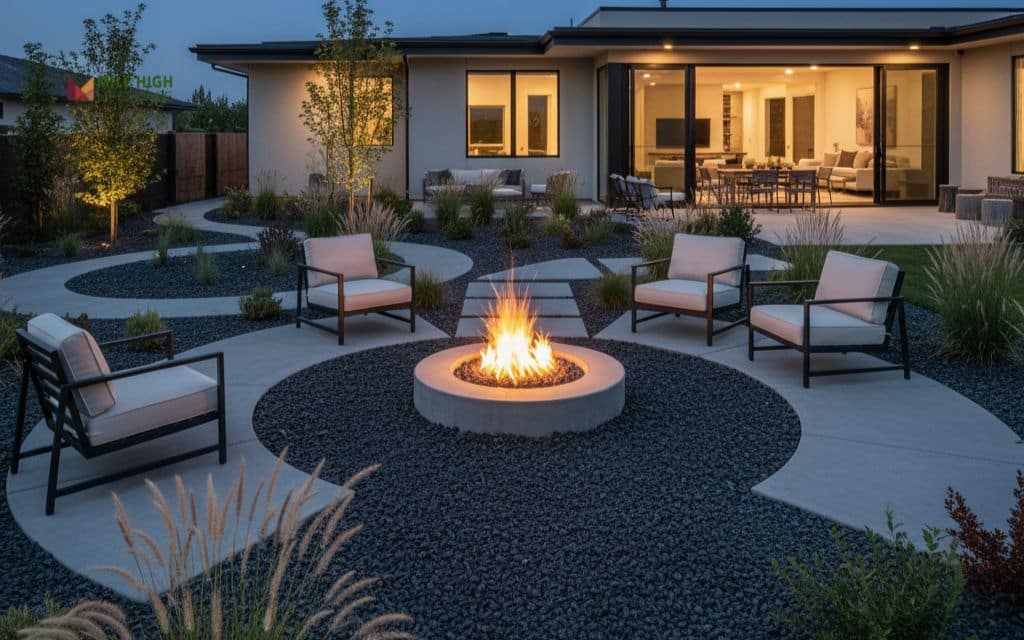
Container garden accents
Use small polished stones to top off planters or pots for a neat, modern finish. This often-overlooked detail elevates container plantings from ordinary to extraordinary.
A 1-inch layer of black polished pebbles serves multiple purposes: it reduces soil moisture evaporation, prevents soil splash during watering, and creates a refined appearance that ties your container gardens together visually.
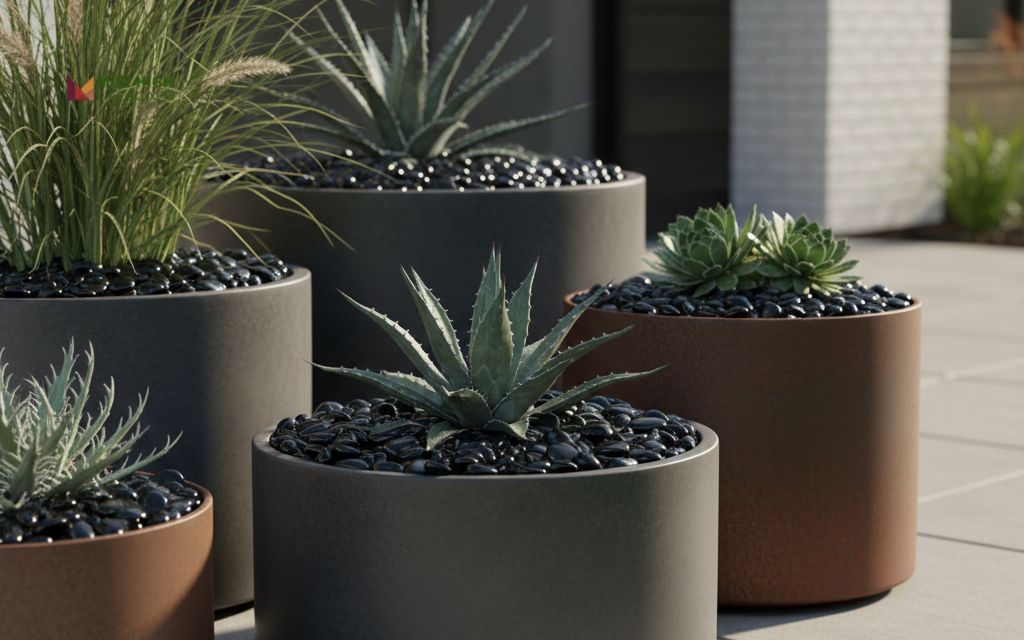
Retaining wall base with black slate
Slate’s flat, layered texture provides excellent contrast against the vertical wall face, whether it’s stone, concrete, or timber. The dark color creates depth and makes plants pop when you add ornamental grasses or trailing perennials.
This approach also solves the common problem of difficult-to-mow areas at wall bases – the slate eliminates the need for string trimming and creates a deliberate, designed look.
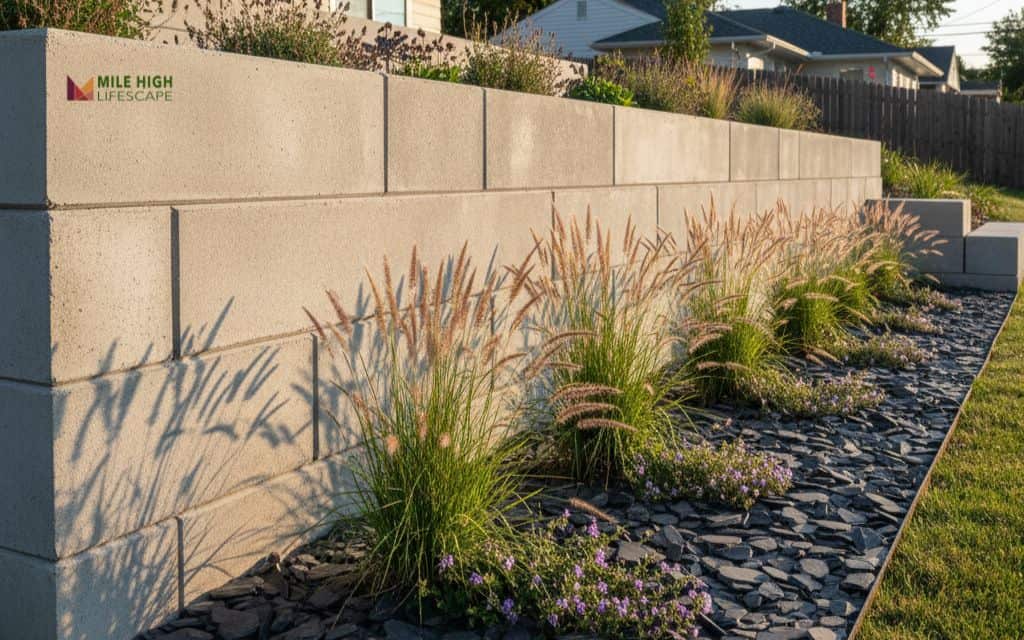
Japanese zen corner
Combine black pebbles with smooth boulders and native grasses for a calm, meditative area. Denver’s intense urban energy makes having a peaceful outdoor retreat invaluable. A Japanese-inspired zen garden design using black rocks creates tranquility through simplicity and careful composition.
Read more: Indoor zen rock garden design: 7 inspiring ideas + complete setup guide
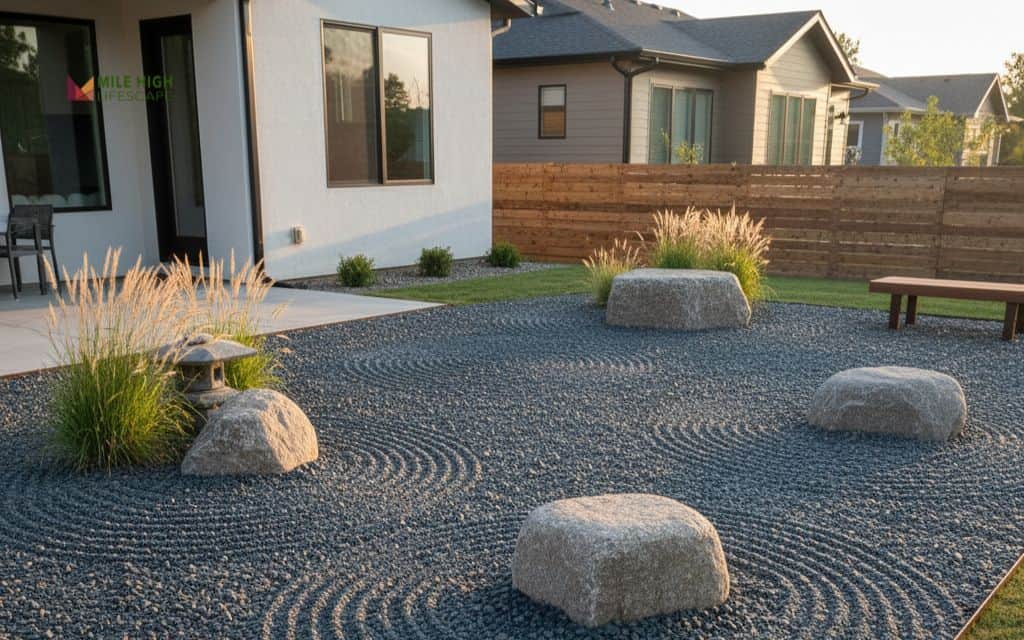
Mixed material driveway
Blend black basalt with light gray pavers for a striking modern pattern that handles snow and drainage. Driveways represent significant real estate in your landscape design, and mixing black rock with pavers creates visual interest while solving practical problems.
Read more: 12 best types of gravel for driveways for Denver homes
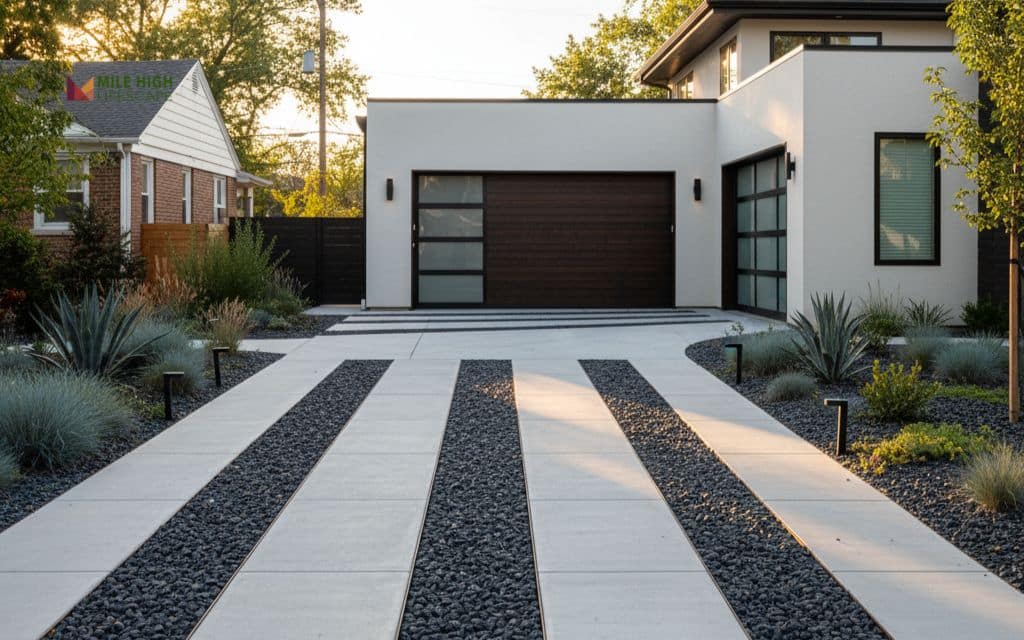
Maintenance tips for black rock landscaping
One of the greatest advantages of a modern black rock landscape is its minimal maintenance requirements. However, a few simple tasks will keep your design looking pristine year after year.
Regular debris removal
Blow off leaves and debris every few weeks, especially during fall when cottonwoods and maples drop their leaves. Use a leaf blower on a low setting to avoid displacing the rocks themselves. This simple task prevents organic material from decomposing on your rocks, which can create discoloration and provide a foothold for weed seeds.
Annual cleaning
Rinse rocks annually to restore their original color and remove accumulated dust. A garden hose with a spray nozzle works perfectly – the water pressure removes surface grime without disturbing your placed design. Late spring, after the last freeze but before summer heat arrives, is the ideal time for this task.
Weed barrier maintenance
Replace any faded or damaged landscape fabric every 5 – 7 years. Even high-quality fabric eventually degrades from UV exposure and will lose its effectiveness. If you notice increased weed pressure in certain areas, it’s likely time for fabric replacement in those spots.
Weed control
Spot-treat emerging weeds with vinegar-based herbicide or remove them by hand when they’re small. A modern black rock landscape significantly reduces weed pressure, but occasional weeds will appear. Address them promptly before they establish root systems or go to seed.
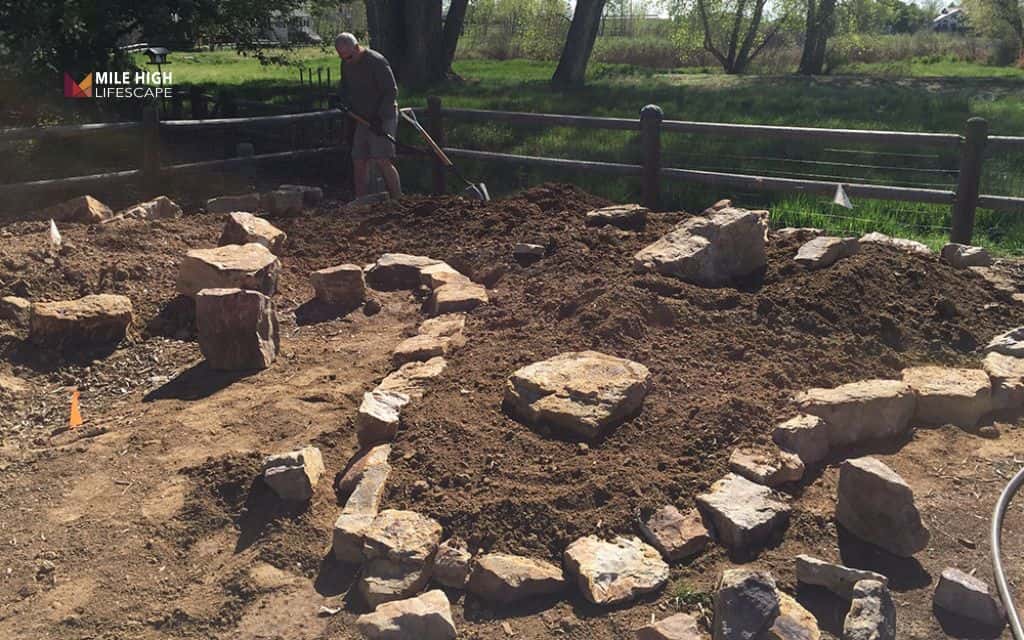
Best plants to pair with black landscape rock (colorado-friendly)
Selecting the right plants is crucial for creating a successful modern black rock landscape. The plants you choose should thrive in Denver’s climate while providing beautiful contrast against the dark rock backdrop.
| Plant Type | Example | Benefit |
| Succulents | Agave, Sedum, Hens-and-Chicks | Low water needs, sculptural shape provides architectural interest |
| Grasses | Blue Fescue, Feather Reed Grass | Soft texture creates contrast to dark rock, movement adds life |
| Perennials | Salvia, Coreopsis, Penstemon | Pops of seasonal color against black backdrop |
| Evergreens | Juniper, Dwarf Spruce, Mugo Pine | Year-round texture and structure |
| Flowering Shrubs | Potentilla, Spirea, Apache Plume | Bright blooms provide balance for modern yards |
Conclusion
Modern black rock landscaping combines beauty, durability, and sustainability, making it well-suited for Denver’s semi-arid climate. From bold basalt walkways to sleek front yard beds, these designs offer a low-water, low-maintenance alternative to traditional grass lawns.
Black rock landscaping reduces water consumption and eliminates regular mowing, which lowers both maintenance time and ongoing costs. The rocks withstand temperature fluctuations and don’t decompose like organic mulch, providing a long-lasting solution.
___________
Mile High Lifescape – Your Modern Black Rock Landscape Experts
For nearly two decades, Mile High Lifescape has helped Denver homeowners create stunning, low-maintenance landscapes using black rock designs. From front yard makeovers to xeriscape transformations, our landscape and hardscape experts provide professional design consultation, quality material sourcing, and skilled installation – all tailored to Colorado.
Ready to transform your outdoor space with modern black rock landscaping?
Contact us: (303) 877-9091
Frequently asked questions (FAQ)
Does black rock landscaping make my yard hotter?
Yes, black rocks absorb more heat than lighter materials. This can raise temperatures in the immediate area, particularly in full sun. Balance this by adding shade plants, mixing in lighter-colored materials, or using black rock in partially shaded areas. Avoid placing black rocks near heat-sensitive plants or against south-facing walls.
How deep should I install black rock?
Install 2 – 3 inches for decorative beds and ground cover. Use 4 inches for driveways or high-traffic areas. Always place landscape fabric underneath to prevent weeds, and add a gravel base layer for proper drainage.
Can I mix black rock with mulch or lighter stones?
Yes. Mixing materials adds visual interest and can help moderate soil temperature. Use organic mulch directly around plants for soil health, and black rock for pathways and display areas. Combining black and gray stones creates contrast without stark appearance.
How long does black rock last?
Black lava rock, basalt, granite, and slate last 20+ years with minimal maintenance. They don’t decompose like mulch and resist fading better than colored rocks. You’ll need to occasionally clean and re-level them, but replacement is rarely necessary.
